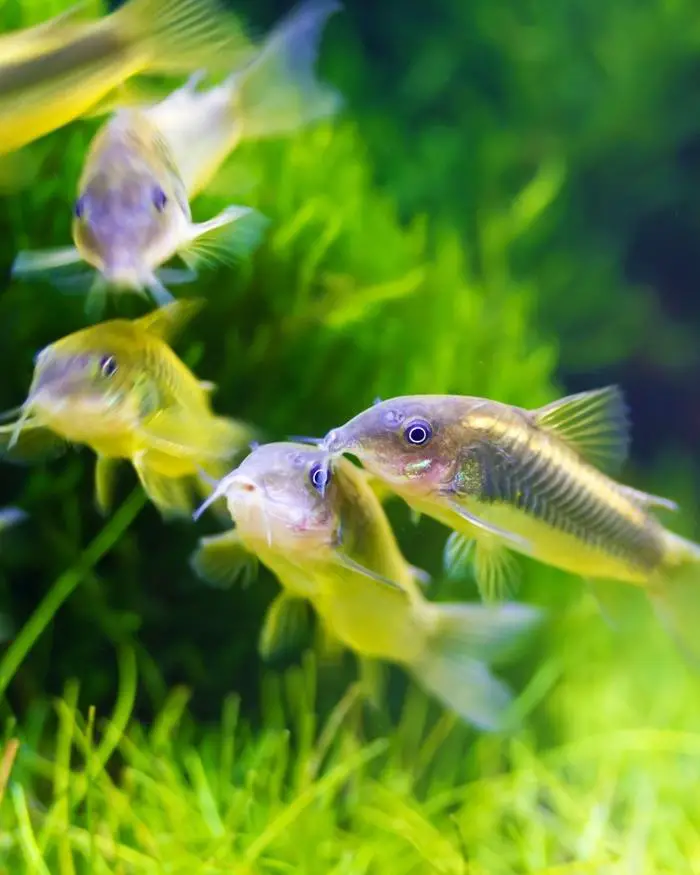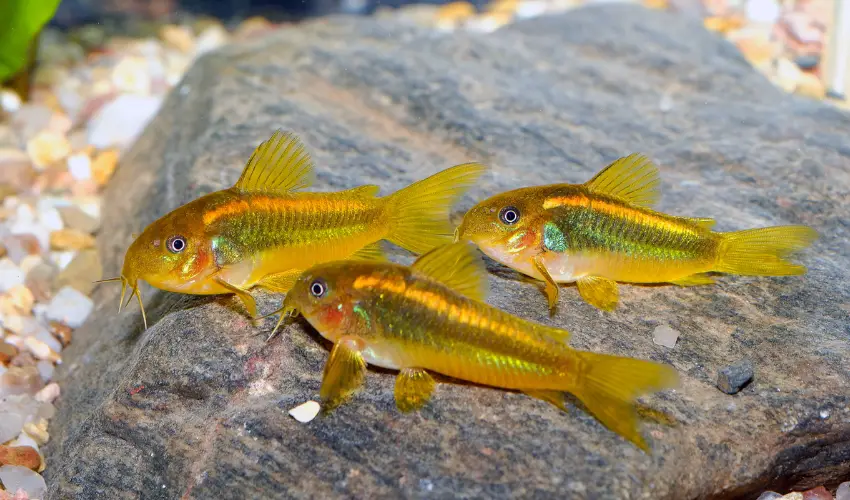Cory catfish are popular aquarium fish for a reason. They’re relatively low-maintenance, peaceful, and have a charming appearance. But one question often arises: Are Cory catfish schooling fish?
The answer is yes. Cory catfish are social creatures and thrive in groups. In the wild, they live in schools of hundreds of fish.
While they may not always swim together in perfect formation in an aquarium, they prefer to be kept in groups of at least six individuals.

There are several reasons why Corydoras are schooling fish. First, it helps them to feel safe and secure. When they’re in a group, they’re less likely to be preyed upon by predators.
Second, schooling allows them to find food more efficiently. They can work together to sift through the substrate and root for detritus and other small organisms.
If you’re considering adding cory catfish to your aquarium, get at least 6 of them. They’ll be happier and healthier in a group. Get ready for the shocking truth about Cory Catfish schooling habits!
Table of Contents
ToggleWhat Are Cory Catfish?
Before delving into their schooling behavior, let’s introduce Cory Catfish. These adorable aquatic creatures belong to the Corydoras genus and are called “Cories” in the aquarium hobby.
They come in various species, such as the popular Panda Cory, Albino Cory, Bronze Cory, and Pygmy Cory. Corydoras are freshwater bottom-dwellers known for their distinctive appearance with armored plates and whisker-like barbels around their mouths.
Are Cory Catfish Schooling Fish?
Yes, cory catfish are schooling fish. They are social creatures that prefer to live in groups of at least 6 individuals. Cory catfish live in shoals of hundreds of fish in the wild, providing protection from predators and helping to find food.
While Corydoras can survive alone in an aquarium, they are much happier and healthier when kept in groups. They will be more active and playful and less likely to become stressed or sick.

Cory catfish schooling behavior is more tight-knit than other schooling fish, such as danios or tetras. They may wander off occasionally but usually stay close to other Corydoras.
If you are keeping Cory catfish in your aquarium, providing them with a large enough tank to swim and explore freely is important. A group of 6 cory catfish will need a tank of at least 20 gallons, and a larger tank is even better.
Here are some of the benefits of keeping Cory catfish in a school:
- They are more active and playful.
- They are less likely to become stressed or sick.
- They are more likely to breed successfully.
- They provide a more natural and visually appealing environment for your aquarium.
Cory Catfish Social Behavior
One fascinating aspect of Cory Catfish is their social behavior. These fish are inherently social and thrive in the company of their kind. Corydoras live in groups in their natural habitat, forming what is known as a “shoal” or a “school.”
Observing a tight school of Cory Catfish in the wild is a mesmerizing sight as they navigate the riverbed together, foraging for food and seeking shelter.
Do Cory Catfish Need to School?
Now, let’s address the burning question: Do Cory Catfish need to school in an aquarium? The answer may surprise you. While Cory Catfish are social, they don’t necessarily require a school to thrive in captivity.
Unlike some fish species that may become stressed or unhealthy when kept alone, Cory Catfish can adapt well to solitary life in your tank.
However, keeping them in a group is recommended for several reasons. When you keep Cory catfish together, they tend to exhibit more natural behaviors, such as swimming freely and engaging in social interaction.
Additionally, Corydoras are more likely to forage for food together in a group, creating a lively and dynamic aquarium environment.
How Many Cory Catfish Should We Keep Together?
Cory catfish are shoaling fish, which means they prefer to live in groups. The minimum number of cory catfish that you should keep together is 6. This will allow them to feel comfortable and safe, and it will also help to reduce stress.
You can keep more than six Cory catfish in a larger tank. The more cory catfish you have, the more active and playful they will be. A good rule of thumb is to keep at least one Cory fish per 5 gallons of tank volume.
Here are some additional tips for keeping Corydoras:
- Keep them in a school of at least 6 of the same species.
- Provide them with enough hiding places like rocks, driftwood, and plants.
- Feed them a diet that is high in protein and sinking foods.
- Keep the water quality in their tank clean and well-maintained.
Here are some examples of how many Cory catfish you can keep in different tank sizes:
- 10-gallon tank: 4-6 Corys fish
- 20-gallon tank: 6-10 Corydoras
- 30-gallon tank: 10-15 Corydoras catfish
- 40-gallon tank: 15-20 cory catfish
If you are still determining how many cory catfish you can keep in your tank, it is always best to avoid caution and keep fewer fish. You can always add more Corydoras later if you have the space.
Ideal Tank Size for Cory Catfish
It’s crucial to provide an adequately sized tank. To ensure the well-being of your Corydoras Catfish, Depending on the species and the number of Corydoras you plan to keep, tank size requirements may vary.
Generally, a 10-gallon tank is suitable for a small group of Cory Catfish, but larger community tanks, such as a 20-gallon setup, can comfortably accommodate more fish.
Mixing Different Species of Cory Catfish
Aquarists often wonder if they can keep different species of Corydoras in the same tank. The good news is that many Cory catfish species can coexist peacefully.
It doesn’t matter whether you have Panda Corys, Bronze Corys, or Pygmy Corys – they can live together harmoniously. Ensure that you provide enough hiding spots and a suitable substrate for them to explore.
Cory Catfish Tank Mates
Choosing the right tank mates for your Cory Catfish is another important consideration. Cory Catfish are social and peaceful fish that generally get along well with various other species.
Some excellent tank mates include peaceful tetras, small shrimp, and snails. However, avoid housing them with aggressive or larger fish that might intimidate or harm the Corydoras catfish.
Creating the Perfect Cory Catfish Habitat
Focus on replicating their natural environment to create an ideal habitat for your Cory Catfish. Use a sandy or fine-gravel substrate to protect their delicate barbels while they search for food.
Provide plenty of hideouts, such as caves or driftwood, as these fish appreciate sheltered areas. Live plants can also be a great addition, enhancing the aesthetics of the tank and offering additional hiding places.
Commonly Asked Questions about Corydoras Schooling (FAQs)
How many Cory Catfish should I keep together?
Keeping Cory Catfish in a group of at least six individuals is recommended. This allows them to exhibit more natural social behaviors.
Can I keep only one Cory Catfish?
While it’s possible to keep a single Cory fish, they tend to thrive and display more natural behaviors when kept in a group.
Do Cory Catfish get along with Betta fish?
Cory Catfish and Betta fish can coexist peacefully in the same tank, provided the tank is of sufficient size and has plenty of hiding spots to reduce potential aggression.
What do Cory Catfish eat?
Cory Catfish are omnivores and enjoy a diet of sinking pellets, frozen or live foods like bloodworms and brine shrimp, and algae wafers.
Final Thoughts
So, are Cory catfish schooling fish? In conclusion, while Cory Catfish are not schooling fish in the strictest sense, they are social creatures that benefit from being kept in groups. It’s advisable to keep them in a small shoal. To ensure the happiness and well-being of your Corydoras, By providing a suitable tank environment with hiding spots and compatible tank mates, you can create a thriving aquatic community that showcases the charming nature of Cory Catfish. So, consider forming a mini-school of these delightful bottom-dwellers in your aquarium, and watch as they bring life and character to your aquatic world.
You might also like
- 7 Best Types of Catfish for Aquarium: Boost Your Tank Beauty
- Cory Catfish With Betta: 5 Surprising Secrets for Success!
- How Many Cory Catfish in a 10 Gallon Tank: (Shocking Truth)
- How Big Do Albino Cory Catfish Get? (A Comprehensive Guide)
- Are Albino Cory Catfish Blind? Let’s Clear Up the Confusion
- Can Different Cory Catfish Breed! – (Is It Even Possible?)
- How Many Cory Catfish in a 20 Gallon Tank? (Must Read)
- Are Cory Catfish Aggressive: 5 Proven Ways to Tame Them!
- Do Corydoras Clean the Tank Effectively: (Find Out Now!)





